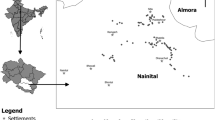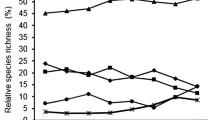Summary
Birds searching for insects in the canopy of a northern hardwoods forest depart significantly from random in their use of tree species, even when these trees are generally similar in life form. All 10 foliage-dwelling bird species in the Hubbard Brook forest showed preferences for Yellow Birch, most had an aversion to Beech and Sugar Maple, and a few had special preferences for conifers or White Ash. Birds that glean prey from leaves had stronger tree species preferences than those that often hover for their prey, and were more influenced by tree species differences in foliage structure. The less common bird species and those for which northern hardwoods are marginal habitat had the most pronounced tree-species preferences. Food densities which are higher on Yellow Birch and specific adaptations to foraging in trees with particular foliage structures are considered major factors responsible for the observed tree species preferences. The implications of these findings for bird community structure and for forest management practices are discussed.
Similar content being viewed by others
References
Anderson SH, Shugart HH (1974) Habitat selection of breeding birds in an east Tennessee deciduous forest. Ecology 55:828–837
Balda RP (1969) Foliage use by birds of the oak-juniper woodland and ponderosa pine forest in South-eastern Arizona. Condor 71:399–412
Bent AC (1950) Life histories of North American wagtails, shrikers, vireos and their allies. US Nat Mus Bull 197:1–411
Bent AC (1953) Life histories of North American wood warblers. US Nat Mus Bull 203:1–734
Cottam G, Curtis JT (1956) The use of distance measures in phytosociological sampling. Ecology 37:451–460
DeGraaf RM (1977) Proceedings of the workshop on nongame bird habitat management in the coniferous forests of the western United States. US Dept Agric-Forest Service General Technical Report PNW-64
DeGraaf RM (1978) Proceedings of the workshop management of southern forests for nongame birds. US Dept Agric-Forest Service General Technical Report SE-14
Dickson JG, Conner RN, Fleet RR, Kroll JC, Jackson JA (1979) The role of insectivorous birds on forest ecosystems. Academic Press New York
Eckhardt RC (1979) The adaptive syndromes of two guilds of insectivorous birds in the Colorado Rocky Mountains. Ecol Monogr 49:129–149
Franzreb KE (1978) Tree species used by birds in logged and unlogged mixed coniferous forests. Wilson Bull 90:221–238
Hartley PHT (1953) An ecological study of the feeding habits of the English titmice. J Anim Ecol 22:261–288
Holmes RT, Sturges FW (1975) Avian community dynamics and energetics in a northern hardwoods ecosystem. J Anim Ecol 44:175–200
Holmes RT, Bonney RE Jr, Pacala SW (1979a) Guild structure of the Hubbard Brook bird community: a multivariate approach. Ecology 60:512–520
Holmes RT, Schultz JC, Nothnagle P (1979b) Bird predation on forest insects: an exclosure experiment. Science 206:462–463
Horn HS (1971) The adaptive geometry of trees. Monogr in Pop Biol 3 Princeton Univ Press Princeton
James FC (1971) Ordinations of habitat relationships among breeding birds. Wils Bull 83:215–236
James RD (1976) Foraging behavior and habitat selection of three species of vireos in southern Ontario. Wilson Bull 88:62–75
James RD (1979) The comparative foraging behaviour of Yellowthroated and Solitary Vireos: the effect of habitat and sympatry. In: The Role of Insectivorous Birds in Forest Ecosystems JG Dickson, RN Conner RR Fleet, JC Kroll, JA Jackson (eds), Academic Press New York p 137–163
Karr JR, Roth RR (1971) Vegetation Structure and avian diversity in several New World areas. Amer Natur 105:423–435
MacArthur RH, MacArthur JW (1961) On bird species diversity. Ecology 42:594–598
Morse DH (1978) Structure and foraging patterns of flocks of tits and associated species in an English woodland during the winter. Ibis 120:298–312
Rice JC (1978) Ecological relationships of two interspecifically territorial Vireos. Ecology 59:526–538
Robinson SK (1981) Social interactions and ecological relations of Philadelphia and Red-eyed Vireos in a New England forest. Condor 83:in press
Roth RR (1976) Spatial heterogeneity and bird species diversity. Ecology 57:773–782
Sokal RR, Rohlf FJ (1969) Biometry. San Francisco: WH Freeman and Co
Whittaker RH, Bormann FH, Likens GE, Siccama TG (1974) The Hubbard Brook ecosystem study: forest biomass and production. Ecol Monogr 44:233–254
Willson MF (1970) Foraging behavior of some winter birds of deciduous woods. Condor 72:169–174
Willson MF (1974) Avian community organization and habitat structure. Ecology 55:1017–1029
Author information
Authors and Affiliations
Rights and permissions
About this article
Cite this article
Holmes, R.T., Robinson, S.K. Tree species preferences of foraging insectivorous birds in a northern hardwoods forest. Oecologia 48, 31–35 (1981). https://doi.org/10.1007/BF00346985
Received:
Issue Date:
DOI: https://doi.org/10.1007/BF00346985




